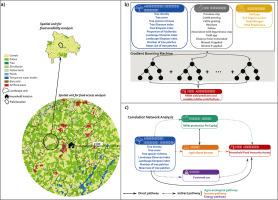Agricultural Systems ( IF 6.6 ) Pub Date : 2021-11-19 , DOI: 10.1016/j.agsy.2021.103312 L. Leroux 1, 2, 3 , N.F. Faye 4 , C. Jahel 5, 6 , G.N. Falconnier 2, 7 , A.A. Diouf 3 , B. Ndao 3 , I. Tiaw 3 , Y. Senghor 8 , G. Kanfany 8 , A. Balde 9 , M. Dieye 6 , N. Sirdey 4, 10, 11 , S. Alobo Loison 12 , M. Corbeels 2, 13, 14 , F. Baudron 15 , E. Bouquet 11, 16

|
CONTEXT
Fostering diversity within agricultural systems can substantially contribute to improved food security among smallholder farmers. Agroforestry parklands are diverse agricultural landscapes where trees can provide an array of ecosystem services. Previous studies analyzing the agricultural landscape diversity-food security nexus in agroforestry parklands have only considered tree cover.
OBJECTIVE
We propose an original empirical approach that combines the analysis of spatial data on agricultural landscape diversity with agricultural field monitoring and household surveys. These three sources of data were used to scrutinize the direct and indirect contributions of agricultural landscape diversity to food availability and food access.
METHODS
Millet yield was used as a proxy for food availability, and household food access was approximated using the Household Food Insecurity Access Scale (HFIAS) indicator. Two contrasted agroforestry parklands of Central Senegal were chosen as case studies. Firstly, we used a Gradient Boosting Machine (GBM) algorithm to disentangle the relative contribution of landscape diversity, biophysical and crop management variables in explaining millet yield variability. Secondly, we investigated the pathways linking agricultural landscape diversity to HFIAS using a Correlation Network Analysis (CNA).
RESULTS AND CONCLUSIONS
The GBM model explained 77% and 84% of millet yield variability for the two parklands, respectively, with landscape diversity variables accounting for 53% and 47% of relative influence. Among the landscape diversity variables, tree species richness and tree density were the most important ones. Millet yield was positively associated with tree density in the Nioro site until a threshold of 5 trees/ha, and with tree species richness in the two sites. The CNA showed that greater tree cover and larger tree patches were moderately correlated with HFIAS. This suggests that tree species with large crown, as it the case for most fruit bearing tree species in the region, are the main species contributing directly to food access. Agricultural landscape diversity contributed mainly indirectly to household food access through an “agroecological pathway”, i.e. by the provision of ecosystem services regulating and supporting crop production.
SIGNIFICANCE
Using an integrated landscape approach relying on up-to-date remote sensing data and recent advances in data analysis methods, our study shows that tree species diversity matters as much as the amount of tree cover for the production of food, and it can contribute to improve food security. We bring a more nuanced picture of the contribution of agricultural landscape diversity to food security suggesting that land management policies supporting food security should consider both tree density and tree species diversity to optimize the co-benefits of trees for the different food security dimensions.
中文翻译:

探索农业景观多样性与粮食安全的关系:对塞内加尔中部两个对比鲜明的公园进行分析
语境
在农业系统内培养多样性可以大大有助于改善小农的粮食安全。农林业公园是多样化的农业景观,树木可以提供一系列生态系统服务。先前分析农林林地中农业景观多样性与粮食安全关系的研究仅考虑了树木覆盖情况。
客观的
我们提出了一种原创的实证方法,将农业景观多样性的空间数据分析与农田监测和住户调查相结合。这三个数据来源用于审查农业景观多样性对粮食供应和粮食获取的直接和间接贡献。
方法
小米产量被用作粮食供应的替代指标,而家庭粮食获取量则使用家庭粮食不安全获取量表 (HFIAS) 指标进行估算。选择了塞内加尔中部的两个对比鲜明的农林业公园作为案例研究。首先,我们使用梯度提升机 (GBM) 算法来解开景观多样性、生物物理和作物管理变量在解释小米产量变异性方面的相对贡献。其次,我们使用相关网络分析 (CNA) 研究了将农业景观多样性与 HFIAS 联系起来的途径。
结果和结论
GBM 模型分别解释了两个公园77% 和84% 的小米产量变异性,景观多样性变量占相对影响的53% 和47%。在景观多样性变量中,树种丰富度和树木密度是最重要的。小米产量与 Nioro 站点的树木密度呈正相关,直到阈值为 5 棵树/公顷,并且与两个站点的树种丰富度呈正相关。CNA 显示更大的树木覆盖和更大的树木斑块与 HFIAS 中度相关。这表明树冠大的树种,正如该地区大多数果树种的情况一样,是直接促进食物获取的主要树种。农业景观多样性主要通过“农业生态途径”间接促进家庭粮食获取,即
意义
我们的研究使用依赖于最新遥感数据和数据分析方法的最新进展的综合景观方法,表明树种多样性与用于生产食物的树木覆盖量一样重要,并且可以有助于改善粮食安全。我们对农业景观多样性对粮食安全的贡献进行了更细致的描述,这表明支持粮食安全的土地管理政策应考虑树木密度和树种多样性,以优化树木对不同粮食安全维度的共同利益。


























 京公网安备 11010802027423号
京公网安备 11010802027423号